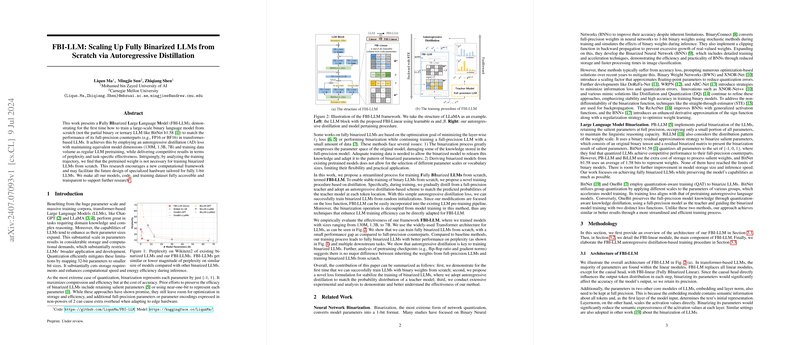An Analytical Overview of "FBI-LLM: Scaling Up Fully Binarized LLMs from Scratch via Autoregressive Distillation"
The paper "FBI-LLM: Scaling Up Fully Binarized LLMs from Scratch via Autoregressive Distillation" authored by Liqun Ma, Mingjie Sun, and Zhiqiang Shen, introduces the concept of Fully Binarized LLMs (FBI-LLMs), offering an avant-garde methodology for training LLMs with binary weights directly from scratch. This work departs from conventional quantization strategies by focusing purely on 1-bit binarization, thus promising notable enhancements in storage and inference efficiency while maintaining performance parity with full-precision models.
Methodological Innovations and Training Architecture
FBI-LLM presents a sophisticated yet streamlined methodology for training binarized LLMs. The architecture incorporates FBI-Linear modules replacing traditional linear layers, utilizing learnable scaling parameters ( and ) to mitigate binarization inaccuracies. This binarized approach is applied to models while retaining the embedding, LayerNorm, and head layers in full precision to maintain semantic integrity and numerical stability.
A pivotal innovation is the autoregressive distillation (AD) technique used in the training process. Instead of directly minimizing cross-entropy with one-hot labels typical for LLMs, AD leverages the probability distribution from a pretrained teacher model to guide the binarized student model. This distillation loss simplifies the training pipeline and improves the parameter optimization trajectory, yielding performance highly competitive with full-precision counterparts.
Empirical Results and Performance Evaluation
The empirical evaluation of FBI-LLM spans model configurations of 130M, 1.3B, and 7B parameters, targeting diverse LLM sizes. The FBI-LLMs exhibit a performance gap that remains small when compared to their full-precision analogs, showcasing robust perplexity and downstream task effectiveness. Notably, the FBI-LLM 1.3B model achieves up to 87% of the performance of full-precision models of similar scale, thereby asserting the feasibility of binary-weight LLMs for practical applications.
Performance metrics highlight that the FBI-LLMs excel in achieving lower perplexity and improved downstream accuracy. For instance, the 1.3B-scale FBI-LLM demonstrates superior results on tasks like BoolQA and OpenbookQA, surpassing binary and even some ternary quantized models like BitNet b1.58 across multiple tasks.
Analysis and Theoretical Implications
A deep dive into the training stability and model behavior reveals critical insights. The research finds negligible differences in the effectiveness of training from scratch versus continuing from a pretrained LLM, attributing instability in the latter method to inherent divergences in parameter space patterns between binarized and full-precision models. This realization simplifies the training process, advocating for direct training from scratch as a viable and stable approach for binarized LLMs.
The paper employs metrics such as the flip-flop ratio and gradient norms to track training dynamics. The results underscore the relative stability of scratch-training binarized models, observing occasional but manageable instability spikes, thus validating the robustness of the proposed methodology.
Practical Implications and Future Directions
FBI-LLM paves the way for future LLM implementations that are more storage and computation-efficient. The hardware implications are substantial, considering the drastic reduction in model size and computational load, potentially influencing the future design of specialized hardware for 1-bit LLM inference.
Future research could explore the binarization of intermediate activations and further hardware optimization to realize full-speed benefits. Additionally, scalable training methods that harness larger training datasets efficiently could refine FBI-LLMs' capabilities, pushing them closer to full-precision performance levels.
In summary, the FBI-LLM framework represents a significant methodological advancement for the training of binarized LLMs, potentially setting a precedent for future AI model design and deployment. The work's empirical success and analytical insights offer a compelling perspective on the viability of extreme quantization in neural model training, heralding a new era of efficient, high-performance neural LLMs.
